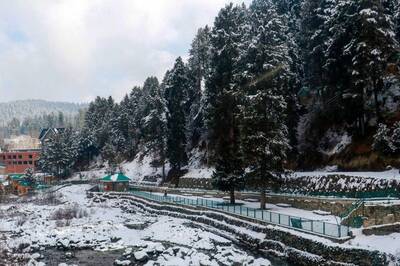
views
New Delhi: Delhiites breathed easy on Saturday as pollution levels in the national capital reduced significantly owing to gusty winds and rainfall in neighbouring areas.
The overall air quality index (AQI) fluctuated between 128 and 157, which falls in the moderate category, according to the Central Pollution Control Board's data.
Barring Dwarka Sector 8, where the air quality remained "poor" (238), most of the areas in the city recorded an AQI in the "moderate" category.
An AQI between 0 and 50 is considered 'good', 51 and 100 'satisfactory', 101 and 200 'moderate', 201 and 300 'poor', 301 and 400 'very poor', and 401 and 500 'severe'.
Kuldeep Srivastava, a senior scientist at the India Meteorological Department, said winds gusting up to 88 kilometers per hour barrelled through Delhi and neighbouring areas on Friday evening, resulting in significant reduction in concentration of pollutants.
Also, rainfall in Punjab, Haryana, and nearby areas due to a western disturbance reduced the effect of stubble burning on the city's air quality, he said.
"Winds clocking 20-25 kilometers per hour will continue to blow in Delhi for the next two to three days, which is favourable for air quality. But, the direction will completely change to northwesterly October 21 onwards," Srivastava said.
Westerly and northwesterly winds bring dust from western regions and smoke caused by burning of crop residue in neighbouring Punjab and Haryana to Delhi-NCR.
The Ministry of Earth Sciences' air quality forecast and research service, SAFAR, said, "At the onset of westerly disturbances, sometime unexpected showers occur which wash away pollutants and provide respite for a short period but western disturbance withdrawal in two to three days will bring cold moisture and deteriorate air quality."
The intensity of stubble burning in Haryana, Punjab, and nearby border regions is almost the same as the past three days but "due to the change in circulation pattern and wet transport path,
its influence in Delhi is negligible", the System of Air Quality and Weather Forecasting and Research (SAFAR) said.
By October 21, a change in the wind direction to northwesterly, moist condition and considerable biomass plume transport is expected. Quick deterioration of air quality to 'poor' and then to 'very poor' category is likely by October 22, it said.
SAFAR data showed the share of smoke from stubble burning in neighbouring states on Delhi's PM2.5 concentration was nil on Saturday. It will increase to five per cent on Sunday and to 15 per
cent on Monday.
According to Central Pollution Control Board (CPCB) data, more than 3,000 stubble burning incidents have occurred in Punjab and Haryana since the harvesting of paddy crop started around September 25. During the corresponding period last year, the count was around 2,600.
Meanwhile, the Delhi cabinet on Saturday cleared a proposal to carry out a mass awareness campaign on pollution and pollution-control measures.
The cabinet has approved an expenditure of Rs 36 crore from the budget of the Directorate of Information and Publicity (DIP) towards the awareness campaigns.
"While there has been a 25 per cent reduction in pollution in Delhi, the winter months see a major spike in pollution levels. One of the major reasons for this is stubble burning in neighbouring states, over which the Delhi government has no control.
"Therefore, the only option available to the people of Delhi is emergency measures to severely cut down on any sources of pollution emanating from Delhi, as well as to find mechanisms by which people can cope with the rising pollution levels," a government statement said.




















Comments
0 comment